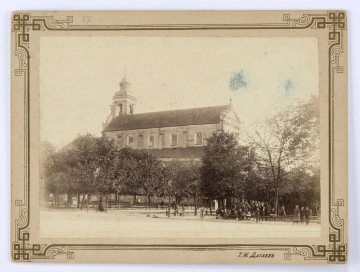
Bernardine Church
1890 — 1910
National Museum in Lublin
Part of the collection: Photographs of Lublin
One of the most interesting sacral architectural monuments of Lublin is the Baroque church dedicated to the Transfiguration of Christ in today's Kardynała Stefan Wyszyńskiego Street (former part of Zamoyska Street). The church, built on the plan of an isosceles cross, was crowned in the middle with a dome and a high tower rising from it. The church was founded in 1696 thanks to the efforts of the chamberlain of Lublin, Anna Zbąska, née Stanisławska (recognised as the first Polish poetess), and the voivode of Lublin, Jan Tarło. It was intended for the missionary fathers, who were entrusted with running the seminary founded by the Lublin townspeople over twenty years earlier. Initially it existed at the parish church in the Old Town, then it was moved to the suburbs, near the newly built church, to a building with a beautiful frieze depicting the figures of Polish rulers.
After the suppression of the Jesuit order, at the end of the 18th century, additional funds were allocated to the seminary. The missionaries took care of it until 1864, when their congregation was dissolved. From then on, the seminary building remained under the administration of lay priests.
The church founded by Anna Zbąska was consecrated in 1739. Its builder is considered Mikolaj Augustynowicz, the superior of the Order of Missionary Fathers. To this day the church serves the Major Seminary.
A photograph taken by Alexander Stepanoff at the end of the 19th century shows the so-called post-Missionary church from behind the plastered fence separating the seminary from the busy street. This road was laid out in the early 1820s. It ran through the gardens of the missionary fathers, which necessitated the levelling of the land. The remaining part of the garden ended with a steep slope separated from the street at first with a provisional fence and later with a plastered brick wall with decorative niches and finials. The entire former monastery complex of the Missionary Fathers has remained a charming place hidden among greenery until the present day.
Author / creator
Dimensions
cały obiekt: height: 20,3 cm, width: 15,1 cm
Object type
photography
Technique
sepia
Material
paper, cardboard, pencil
Creation time / dating
Creation / finding place
Owner
The National Museum in Lublin
Identification number
Location / status

1890 — 1910
National Museum in Lublin

1880 — 1900
National Museum in Lublin

1899 — 1901
National Museum in Lublin
DISCOVER this TOPIC
Museum of King Jan III's Palace at Wilanów
DISCOVER this PATH
Educational path